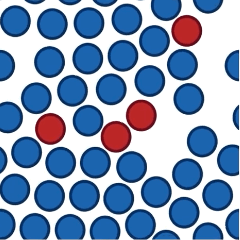Droplet microfluidics- a systems view
Droplet microfluidics is the field of study which consists of producing and manipulating droplets inside very small channels for different applications that range from particle synthesis to DNA sequencing to soft computing. An experimentalist who fabricates a microchannel and observes the motion of droplets in the channel typically solves the forward problem which involves understanding the behaviour of droplets for a given geometry and operating condition. However, a design problem is an inverse problem as it involves identifying the geometry and operating strategy required to yield the desired behaviour of droplets in a microchannel. And the non-linear nature of droplet flow which results in collective droplet motion renders design non-intuitive. Hence, there is a need for a systematic approach to design which would involve posing the design problem as an optimization problem. However, the multi-scale nature of the flow problem makes the conventional computational fluid dynamics approach infeasible for design. And, without a computationally simple modelling strategy for droplet flow, it will be impossible to uncover the full potential of the droplet microfluidics technology. Hence, during my doctoral work, I proposed to address this problem by introducing the agent-based approach to simulate complex droplet flow and behavior in microchannels.
Agent based approach
Flow of drops in a microchannel is similar to the flocking of birds in nature- in that it exhibits collective behavior. As a drop travels in a microchannel it generates circulations in the flow as a result of the confinement and the circular nature of the drop. Hence a drop disturbs the fluid particles in its neighborhood. With an increase in the number of drops in the channel, the fluid flow around the drops are perturbed continuously and the drops start to interact hydrodynamically. The non-linear nature of the interactions results in collective drop behavior.
Self-organization of drops
Drops form ordered arrangements inside 2D microchannels. The complex traffic inside the channel is a result of the hydrodynamic interactions of the drops. We propose an agent based approach to model the system. The framework involves identifying the drop-level interactions using simple phenomenological models and a multi-agent simulation which pieces the entity-level information to predict the collective dynamics of the system.
Inverse problems in complex droplet systems
Video Courtesy: Talk given at the International center for theoretical analysis (ICTS- TIFR), Bangalore, India during the summer-2016 program
Hydrodynamic interaction between the drops results in complex droplet behavior inside 2D microchannels. With a computationally simple agent based model, for the flow of drops it is possible to answer several interesting inverse problems that are very important from an engineering perspective. Ex: Drops self-organize to form compact structures; an inverse problem in this case would be, identifying the operating and geometric conditions that will allow us to organize drops to form any arbitrary shape. Pattern formation in the case of composite drops is also discussed.
Coalescence avalanches
An isolated coalescence event, in a concentrated emulsion flowing through a 2D microchannel, can trigger an avalanche of similar events which results in spontaneous destabilization of the droplet assembly. We propose a stochastic model to simulate the phenomenon.


